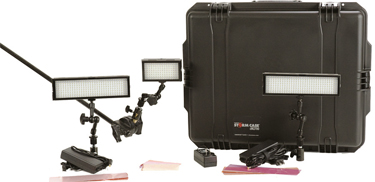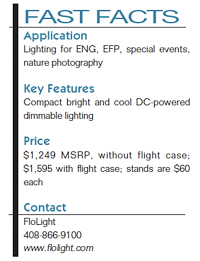FloLight Microbeam SWAT Kit

FloLight Microbeam SWAT kit
Anyone who regularly shoots back-to-back interviews in different locations with multiple lighting setups will appreciate the edge that cool LED lighting offers in terms of fast break downs to speed a move to the next location. As LEDs emit only nominal heat, there's no time lost in waiting for them to cool down. This puts them head and shoulders above quartz lights and their mandatory variable cooling off period before they can be packed up for travel. Depending on their wattage, LEDs can be placed back in their case immediately, or almost immediately after being turned off—in barely the time needed to break down and pack up the stand.
LED lighting kits are a relatively new to the marketplace, but are increasingly popular, especially those that are modular and with higher output light heads. These can be used to create truly luminous point source lighting.
FEATURES
There are now a growing number of portable LED lighting options, including a variety of kits targeting different applications and at different price points. Generally speaking, LED lighting is considerably pricier per Watt than quartz. The tradeoff is that it generates more illumination per Watt than quartz. Hence, it offers economy of size and portability, with the bonus of providing speedy breakdowns and setups. One very portable solution is a new three light kit from FloLight, the Microbeam SWAT kit. It has a combined output equivalent to 500 Watts worth of "hot lighting" (quartz). The kit includes two Microbeam fixtures with 256 ultrabright LEDs in each and a third unit that sports 128 LEDs. The latter is equivalent to a 100 Watt quartz light, and provides 5600 degree K illumination. The lamp head itself is roughly comparable in size to other pro-grade LED camera lights that are designed for convenient mounting atop camcorders. However, unlike most, it can provide an illumination of 746 Lux at a distance of three feet from the subject.
Both the Microbeam 256 and Microbeam 128 lights are designed to be powered by various lithium ion camcorder batteries in the 7 to 16 Volt range. They can be outfitted to accommodate the batteries from most major camera manufacturers, including Canon, JVC, Panasonic and Sony. The higher capacity batteries can power these lights for most of a day's shooting. Each light comes with a choice of battery mounting plates based on your camera make and model. AC power supplies for both Microbeams are also available as an option. The kits also include stands and hotshoe swivel mounts with an articulating arm. The arms make it easier to angle the light head more precisely and effectively. They're designed to be mounted atop the light stand or directly on a camera.
Both the 128 and 256 LED Microbeams are equipped with a dimmer control, with an adjustment range of from zero to 100 percent. The lamp heads are supplied in black, but can be ordered with a red finish if desired. Each Microbeam includes a slide-in filter holder for mounting the set of five gels included with each kit. The set includes various diffuser and color correction gels, including tungsten, warming, 1/4 minus green, 1/2 minus green and diffusion.
Another key feature of the Microbeams is their ability to be stacked for doubling the light output. This effectively transforms a pair of 128s into a 256, and a pair of 256s into a 512. The increase in illumination can be quite impressive, with that provided by a pair of 128s jumping from 746 Lux at three feet to more than 1,400 Lux. A pair of stacked 256 Microbeams boosts the level to more than 2,600 Lux. For comparison, another leading camera-mounted LED fixture provides 581 Lux at three feet.
The Microbeam SWAT kit does not include light stands, but eight-foot stands are available as optional extras and were included with this review kit. The kit does come with a set of articulating arms for each stand. With the arms mounted, the maximum height for each light on a fully extended stand is about 10 feet. This opens the door for many interesting and creative lighting setups, including overhead lighting. Each kit comes with a small utility-style hard plastic Pelican carrying case for the lamp heads and batteries.
IN USE
The review kit included two Microbeam 256s and one Microbeam 128 with articulating arms. There was plenty of hard protective foam padding separating each of the lights and the mounting arms in the case. The lamps were supplied with Sony mounting plates and we used our own high capacity Sony lithium ion batteries, which slid into their mounts with some degree of difficulty, but, once seated, were held snugly in place.
Unlike a quartz "hot light," it was feasible to immediately test the basic operation of both battery and light by simply flipping the power switch. Nothing happened at first, and then I remembered to check the dimmer control which arrived set to zero.
The articulating arms packed with the lamp heads are designed to screw tightly and quickly into either the top or bottom of the Microbeam head. They can then be fastened to the stand pole just like a standard light head with the included standard cylindrical clamp, and are locked onto the shaft with a nut. The articulating arm includes two ball and socket joints that provide extraordinary flexibility—vertically, horizontally, or diagonally. This flexible arm enables you to focus the lamp with uncanny precision, thus allowing you to place more of the Microbeam's illumination on the subject.
In addition to mounting the lights on separate stands for three-point lighting setups, I also tried the Microbeam 128 mounted atop a camera on its articulating arm.
Generally, I use a fairly typical three-point or four-point lighting setup (with sunlight from a large window providing the fourth source), with both side and backlighting. In my test setup, there was also indirect daylight provided by a trio of windows at the far end of a fairly large room.
In one setup, I used all three lights at nearly full intensity, and positioned three to six feet from the subject. In another test, I used only two of the LED lights, and in another test, only one—a 256—serving as an off-center key light, which was supplemented by sunlight from an adjacent window.
While, I got satisfactory results with all three setups, the results I liked best came from the single light setup—a Microbeam 256 was used as key light placed from four to six feet from the subject, and side lighting came from the large window. This arrangement yielded the richest colors and best skin tones. The video shot with the two Microbeam 256's and the 128 was perfectly acceptable, but not quite as rich and intense as that obtained with a single LED source. This also produced a slightly shallower depth of field. Clearly the Microbeam 256 and 128 fixtures both have sufficient output to significantly impact exposure, depth of field and color saturation in an environment with sufficient ambient lighting. In fact, when I dimmed the LEDs down by roughly 50 percent, they mimicked the results obtained with the lone LED plus sunlight. Apparently, there can also be too much of a good thing in terms of lighting.

For purposes of comparison, I shot a very dark subject on an overcast day in the same room. The ambient light was much dimmer, but the lighting setup and camera stayed the same. With all three lights operating at full intensity, the overall result was comparable—good color saturation, plenty of fine detail and fairly good depth of field. However, when I knocked the light level down by half, the black detail level dropped noticeably, as did color saturation and depth of field.
The drop-off in all of these same parameters was even more pronounced when shooting the same subject with one Microbeam 128 in a room that was darker by half. I had to shoot within three to four feet in order to maintain comparable color and detail level. This wasn't surprising, as the total equivalent (hot light) for all three lamps was 500 Watts and only 100 Watts for the single Microbeam 128. The obvious beneficial tradeoff is speed and efficiency when changing setups due to the lack of a lamp cool-down period. There's also no need to locate AC outlets. With the Microbeams, you can literally pick them and their stands up and run to the next location.
SUMMARY
Lighting entirely with lightweight and highly portable battery-powered LED lighting has revolutionized television production work. It provides a major boost in speed and efficiency. The FloLight Three-fixture Microbeam SWAT Kit offers an attractive alternative to standard AC-powered conventional lighting. It's ideal for use in conjunction with daylight in the 5000 to 5600 K range, rather than for lighting large dark spaces. In a daylight supplemental application, the kit can save considerable time by eliminating the need for color conversion and the need to access AC power sources with sufficient capacity to operate multiple high output "hot lights." Being able to break down and pack up the lights immediately after shooting without a cooling down period, saves invaluable time in high pressure run-and-gun situations.
The ability to supplement natural lighting with small LED sources that run for hours without an AC power source is an exciting development in location shooting, and makes it feasible to light remote scenes without lugging along heavy and noisy generators. The Microbeam SWAT kit is ideal for news and outdoor shooting of all kinds, including nature footage, where AC sources are scarce or nonexistent. It opens the door to many possibilities.
Carl Mrozek operates Eagle Eye Media, based in Buffalo, N.Y., which specializes in wildlife and outdoor subjects. His work regularly appears on the Discovery Channel, The Weather Channel, CBS, PBS and other networks. Contact him ateagleye11@gmail.com.
Get the TV Tech Newsletter
The professional video industry's #1 source for news, trends and product and tech information. Sign up below.
